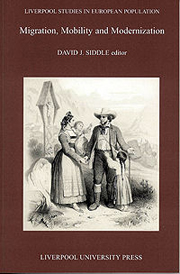Book contents
- Frontmatter
- Contents
- List of Figures
- List of Tables
- 1 Introduction
- 2 Nephews, Dowries, Sons and Mothers: the Geography of Farm and Marital Transactions in Eastern Ireland, c. 1820–c.1970
- 3 Mobility, Kinship and Commerce in the Alps, 1500–1800
- 4 People from the Pits: the Origins of Colliers in Eighteenth-Century South-West Lancashire
- 5 Motives to Move: Reconstructing Individual Migration Histories in early Eighteenth-Century Liverpool
- 6 Urban Population and Female Labour: the Fortunes of Women Workers in Rheims before the Industrial Revolution
- 7 Mobility Among Women in Nineteenth-Century Dublin
- 8 Tramping Artisans in Nineteenth-Century Vienna
- 9 Migration and Urbanization in North-West England: a Reassessment of the Role of Towns in the Migration Process
- Index
7 - Mobility Among Women in Nineteenth-Century Dublin
- Frontmatter
- Contents
- List of Figures
- List of Tables
- 1 Introduction
- 2 Nephews, Dowries, Sons and Mothers: the Geography of Farm and Marital Transactions in Eastern Ireland, c. 1820–c.1970
- 3 Mobility, Kinship and Commerce in the Alps, 1500–1800
- 4 People from the Pits: the Origins of Colliers in Eighteenth-Century South-West Lancashire
- 5 Motives to Move: Reconstructing Individual Migration Histories in early Eighteenth-Century Liverpool
- 6 Urban Population and Female Labour: the Fortunes of Women Workers in Rheims before the Industrial Revolution
- 7 Mobility Among Women in Nineteenth-Century Dublin
- 8 Tramping Artisans in Nineteenth-Century Vienna
- 9 Migration and Urbanization in North-West England: a Reassessment of the Role of Towns in the Migration Process
- Index
Summary
INTRODUCTION
Geographical studies of nineteenth-century Irish urban centres have been dominated by concern with morphology and the built fabric, with attempts to reconstruct the social geography of individual towns and cities heavily dependent on property valuation records, health and housing reports (Royle, 1991; Martin 1988; Aalen, 1992; McCullough, 1989). The compilation of topographical information, most notably in the Irish Historic Towns Atlas series, provides a firm foundation on which to build geographical studies, but the lack of census data at the household level prior to 1901, such as is available for most British cities in the form of census enumerators' books, greatly hinders the follow-through stage of effectively ‘peopling the [Irish] past’ (Lawton, 1987). The search for alternate city-wide sources which provide detail on all residents, rather than on the property they occupy, is still in its infancy. In terms of mobility, recent nineteenth-century research has concentrated on Irish overseas migration flows rather than on movements within Ireland, with the exodus precipitated by the famine holocaust (1845–c.1851) understandably dominating the discussion (McKay, 1990; O'Sullivan, 1995). The experience of the overseas Irish in such places as Liverpool, Manchester, Bristol and York has also received some very close attention, but such studies cannot be replicated in Ireland in the absence of household census data (Letford and Pooley, 1995; Busteed and Hodgson, 1994; Large, 1985; Finnegan, 1982; Swift and Gilley, 1999). Against this background, a gender perspective on geographical mobility in nineteenth-century Dublin is practically non-existent.
- Type
- Chapter
- Information
- Migration, Mobility and Modernization , pp. 131 - 163Publisher: Liverpool University PressPrint publication year: 2000
- 1
- Cited by



